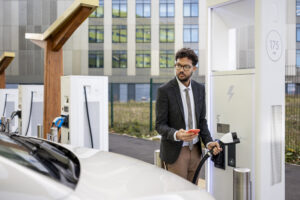
Nearly half of shoppers are rejecting EVs because of infrastructure concerns
By onAnnouncements
A new J.D. Power study found that 49% of people shopping for a new vehicle rejected electric vehicles (EVs) as an option due to infrastructure concerns.
A lack of charging availability has been the No. 1 reason shoppers have opted to stick with internal combustion engine (ICE) vehicles since J.D. Power’s Electrical Vehicle Consideration Study was launched in 2021.
“With all of these influences shaping today’s EV market, the biggest friction point for consideration is the availability of public chargers,” said Stewart Stropp, executive director of EV intelligence at J.D. Power.
“The growth in public charging isn’t keeping pace with the rising number of EVs on the road. While owners are impressed by what automakers are offering, they’re also thinking about how, when and where they’ll be able to charge their vehicles away from home. A resounding effort to build out and improve the public charging infrastructure will emphatically increase EV purchase consideration.”
According to J.D. Power’s research, charging availability has grown slowly year-over-year, rising 13% this year versus last year’s 33% increase.
S&P Global Mobility data has shown that the charging infrastructure is not nearly robust enough to fully support a maturing electric vehicle market. Even when home charging is taken into account, to properly match forecasted sales demand, the U.S. will need to see the number of EV chargers quadruple between 2022 and 2025, and grow more than eight-fold by 2030, S&P says.
Similarly, J.D. Power said that all of its EV-related studies have found public charging infrastructure to yield low satisfaction scores.
“Most EV owners will say charging is one of the greatest benefits of ownership, because 85% of it is done at home,” Stropp said. “But it’s the exceptional use case—like a vacation road trip—that’s holding shoppers back. Proactively taking ownership of the public charging experience is a huge opportunity for automakers to differentiate. The recent announcements by Ford and GM to establish a charging collaboration with Tesla are particularly noteworthy.”
Ford said in May that its EV owners will soon have access to a network of more than 12,000 Tesla superchargers throughout the U.S. and Canada under an agreement between the two automakers.
Next spring, Mustang Mach-E, F-150 Lightning and E-Transit models will be able to connect with the chargers through an adapter and software integration. Beginning in 2025, Ford said its next-generation EVs will eliminate the need for an adapter.
Less than two weeks later, General Motors said that it is also expanding its EV charging access through a partnership with Tesla.
The automaker will integrate the North American Charging Standard (NACS) connector design into its EVs beginning in 2025, it said in a press release.
J.D. Power’s study also found that people who have long commutes are more likely to buy an EV to offset fuel expenses and that consumers who’ve had experience with EVs are more likely to be on board with buying one.
Hyundai is among the automakers who recognize that EV familiarity can lead drivers to make the transition. Earlier this year, it said it was working to satiate drivers’ EV curiosity with a new subscription service that allows users to lock into an EV contract on a month-by-month basis.
Meanwhile, a newly-released Verra Mobility Corporation study of 2,000 U.S. residents aged 25 and older found that 78% of people would consider renting an EV to try out the technology before committing to a purchase.
“Renting an EV is a helpful way to get drivers more comfortable and alleviate concerns,” said Steve Lalla, executive vice president of commercial services at Verra Mobility. “For many people, driving an EV isn’t intuitive. There’s anxiety around the unknown, like maintenance, locating charging stations and how to pay to recharge.”
According to J.D. Power, 26% of shoppers are “very likely” to consider buying an EV, representing a slight increase from 2022.
Last year, 24% of drivers on the market for a new vehicle said they were likely to go with an electric model, and J.D. Power attributed the rise to buyers having more model options and charging ability.
However, it said growth in demand was hampered by lower gas prices, inflation, and rising interest rates.
The survey found those living in California are most likely to buy an EV, with New York coming in second.
Last week, the San Francisco area became the first U.S. region to hit 50% EV adoption.
S&P Global Mobility shared new research this week that showed the San Francisco region’s 50% electrification rate, which includes both EVs and hybrid models, was more than three times greater than the national average of 16.6% during the same March period.
It said the milestone was not likely a fluke, as EVs represented 53.1% of new auto registrations in April.
“In reaching such lofty electrified registration numbers, several brands achieved shares of the EV market in the Bay Area far above their EV shares in the remaining DMAs,” S&P said.
Images
Featured image credit: SolStock/iStock
